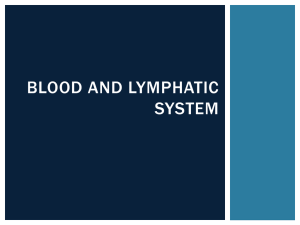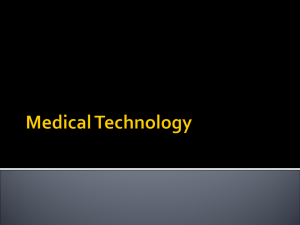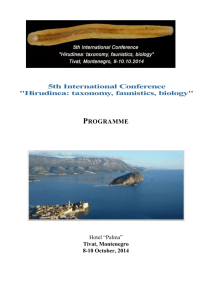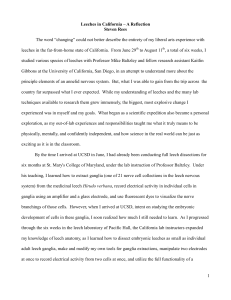Lee
advertisement
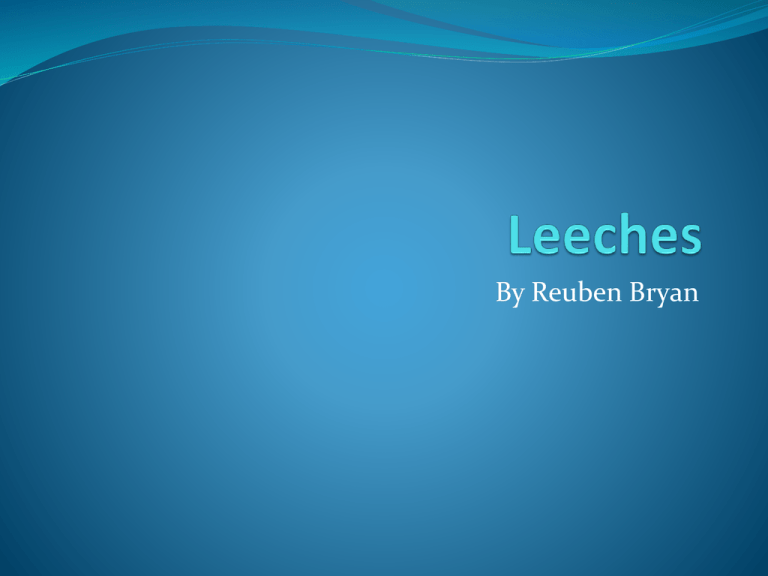
By Reuben Bryan Annelids Related to worms- invertibrates Can’t asexually reproduce, unlike most members of their phylum Segmented with “brains” which are just clumped up nerves called Ganglia. Essentially they have 32 brains, one for each segment Subclass Hirudinea 2 Types With/ without jaws - Arhynchobdellida and Rhynchobdellida Proboscis in jawless, sometimes teeth in jawed Most eat decomposing material Jawed leeches also eat worms snake style Anatomy 2 suckers, one on each end, thinner end is the mouth Light sensitive cells all over their body, some have as many as 16 eyes, some have none Blood up to 5 times their body weight can be stored in their crop, where it is digested by bacteria Habitat Terrestrial, Marine, Freshwater Terrestrial leeches include the predatory leeches and some bloodsucking ones, as well as the benign Marine leeches have proboscis and feed on fish Freshwater are the ones that we are familiar with – include the jawed parasites, proboscis, and benign ones Movement In water: dolphin style On land: inchworm style, or vermiform HOW DO THEY FIND ME!?! On land: highly sensitive to scent, movement, vibrations, ect. In water: shark sense (Blood sense, ect.), vibrations, movement ect. Feeding habits - Predatory Snakelike feeding habits – swallow prey whole They eat earthworms, larvae, snails, and other invertebrates Lack teeth KinaBalu Giant Red Leech– Feeds on worms, located only on Mount Kinabalu, grows up to 30 cm Feeding habits – Parasitic - Jawed Suction on and inject an anesthetic to numb the area, then bite with their three jaws and suck out the blood They feed off of any animal they latch onto, although some of them feed only on fish, or only on amphibians or reptiles or mammals or birds Three jaws, each with approximately 100 teeth Chainstrap Leech Feeding habits – Parasitic - Jawless They have a proboscis, which they insert into the host to suck blood Mainly feed off of fish Most common in the ocean Feeding habits - Benign Feed off of dead or decaying material Cannot bite Properties of saliva Anticoagulant: prevents blood from clotting resulting in: Excessive bleeding for up to 5 hours after a bite Blood inside a leech not going bad, and is thus able to sustain the leech for up to a year, though they usually feed twice a year Digestion Digestive tract: Blood is stored in the crop, then goes through the intestines where the nutrients is absorbed Symbiotic relationship to the bacteria Areomonas Hydrophila – Bacteria secretes an antiboitic the prevents any other bacteria from growing inside the leech, causing the blood to putrefy slower. Also secretes enzymes that play a major role in the leeches digestion Because they are cold blooded, or ectotherms, before feeding, leeches hang out in cold places in the water, while afterwards the leeches hang out in the warm places Medicinal uses Used to save limbs that would otherwise have been lost to clotting and, thus, gangrene In Europe leeches saved the ear of a boy that had been bitten off by a dog Removal DO NOT BURN/ SALT OFF: doing so causes the leech not only to disengage, but to regurgitate the contents of its stomach back into the wound, which is bad Safe way: break suction with fingernail, causing leech to disengage, flick away Dangers Not much: leeches carry parasites sometimes, but they cannot survive inside humans and die Only danger: If the leech fed on someone with a fluid related disease such as HIV/AIDS or the like around 20 hours earlier Too many leeches could remove too much blood Size Largest leech was 18 inches with a six inch proboscis: named Grandma Moses, species: Giant Amazon Leech Smallest leeches are only around 5mm Grandma Moses History The word “Leech” is derived from the Anglo-Saxon word “Loece”, meaning “To Heal” Medieval doctors called themselves Leeches Used to draw blood from hard to reach places, such as the gums, nose, or fingers Became extremely popular in the 19th century; in 1833 alone 14,500,000 leeches were imported to France The medicinal Leech “Hirudo Medicinals” is now endangered as a result Leeches were first used around 1000 B.C., most likely in India More History In 1799, soldiers marching in Egypt from the Sinai Peninsula to Syria drank any water that they could find, and the tiny leeches in the water attatched themselves to the insides of their throats, causing many to die of blood loss or closed off airways from the swollen leeches Barbers got their red stripped poles from leeches, which they used to do surgery on their patients. The bloody cloths were then hung on the poles In 1985, microsurgeons in a Boston hospital used leeches to save the ear of a 5 year old boy that had been bitten off by a dog Fun Facts Leeches can bite through a hippo’s hide, while some firearms cannot The nervous system of a Leech is very similar to a human There are almost 700 species of leech, although there are more than double that number expected Leeches lay their eggs in a cocoon, and the amazon leech keeps them on its belly Leeches Drink up to five times its body weight Jawless leeches cannot swim, despite being located in the ocean Leeches make wonderful pets, and are extremely low maintenance Works Cited "5/1/09 - 6/1/09." Developers Are Crabgrass. Web. 02 June 2011. <http://zaetsch.blogspot.com/2009_05_01_archive.html>. "About Leeches." Leech Therapy - Medicinal Leeches for Sale. Web. 02 June 2011. <http://www.leeches.biz/about-leeches.htm>. "Amazon Leech -- Britannica Online Encyclopedia." Encyclopedia - Britannica Online Encyclopedia. Web. 02 June 2011. <http://www.britannica.com/EBchecked/media/19647/Head-of-the-giant-Amazon-leech-The-retractable-proboscis-is>. "Gallery." CelebBest. Web. <http://celebbest.com/gallery/leech%201>. "HEALTH NEWS." HEADLINED NEWS. Web. 02 June 2011. <http://wydeworld.com/HEALTHNEWS.aspx>. "Invertebrates - Haemopis." Lander. Web. <http://webs.lander.edu/rsfox/invertebrates/haemopis.html>. "Leeches - Australian Museum." Australian Museum - Nature, Culture, Discover - Australian Museum. Web. 02 June 2011. <http://australianmuseum.net.au/Leeches>. "Leeches - Bio and Behavior." Biopharm. Web. <http://www.biopharm-leeches.com/pdf/bioandbehav.pdf>. "Leeches Last Century Medicine and the Bizarre Tempest Prognosticator." Share Knowledge & Earn Passive Income | Factoidz. Web. 02 June 2011. <http://factoidz.com/leeches-last-century-medicine-and-the-bizarre-tempest-prognosticator/>. "Leeches: Unique and Colorful Sucking Creatures | Scienceray." Scienceray | All That Is Science, Astronomy, Biology, Chemistry, Mathematics, Physics. Web. 02 June 2011. <http://scienceray.com/biology/leeches-unique-and-colorful-sucking-creatures/>. "Leeches." Worsley School OnLine... the Website for Worsley School ................... Web. 02 June 2011. <http://www.worsleyschool.net/science/files/leeches/leeches.html>. "Lovable Leeches." Access Excellence @ the National Health Museum. Web. 02 June 2011. <http://www.accessexcellence.org/LC/SS/leechlove.php>. "Maggots and Leeches Make a Comeback." Science in Africa, Africa's First On-Line Science Magazine, Home Page. Web. 02 June 2011. <http://www.scienceinafrica.co.za/2003/july/leech.htm>. "Neuroscience - Leech Pics." People.usd.edu. Web. <http://people.usd.edu/~cliff/Courses/Behavioral%20Neuroscience/Leech/Leechfigs/Leechpics.html>. "Red Gold . Blood Basics . Early Practices . Leeches | PBS." PBS: Public Broadcasting Service. Web. 02 June 2011. <http://www.pbs.org/wnet/redgold/basics/leeches.html>. Scharf, Stanley. "New Page 0." Taunton River Journal. Web. 02 June 2011. <http://www.glooskapandthefrog.org/leach.htm>. "Serotonin and Heat Play a Role in Leeches Abilities." PhysOrg.com - Science News, Technology, Physics, Nanotechnology, Space Science, Earth Science, Medicine. Web. 02 June 2011. <http://www.physorg.com/news/2011-05-serotonin-role-leeches-abilities.html>. "SI NMNH IZ Features - Leeches." SI NMNH Invertebrate Zoology Home. Web. 02 June 2011. <http://invertebrates.si.edu/Features/stories/haementeria.html>.
